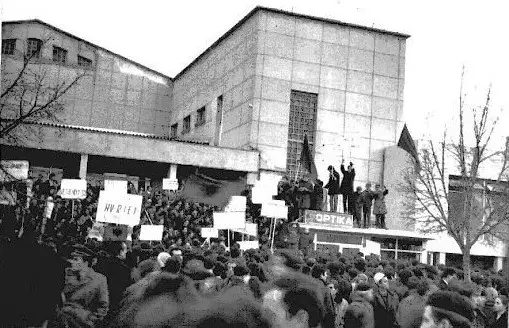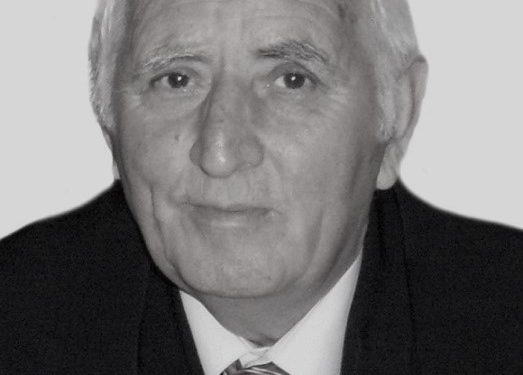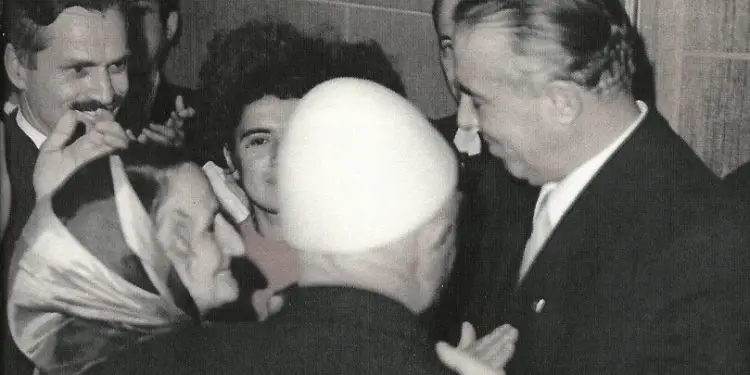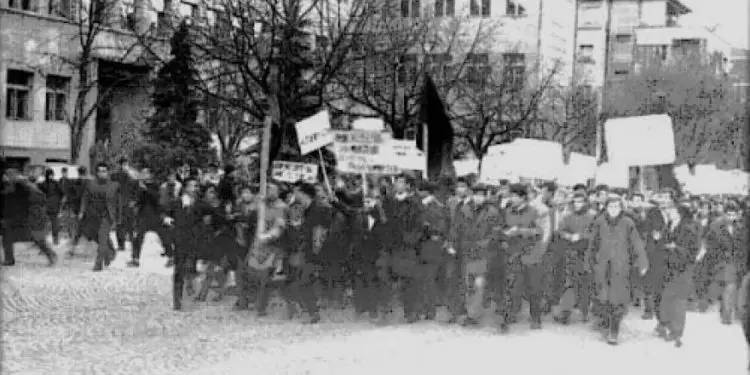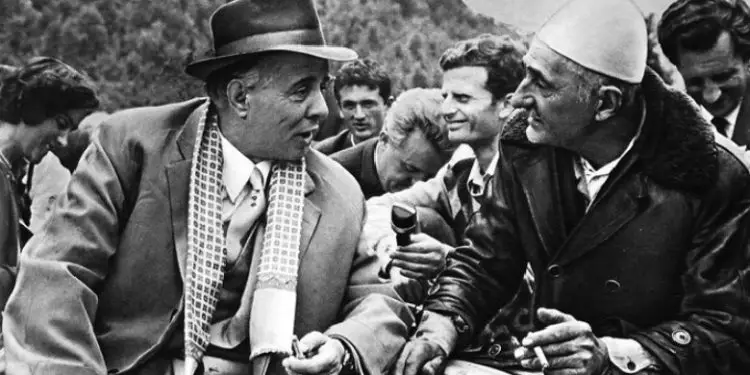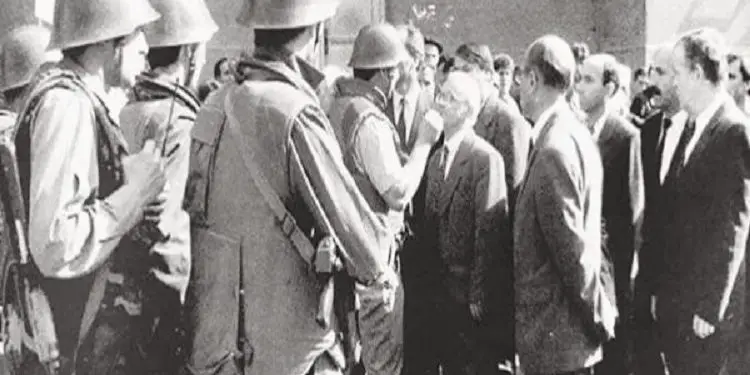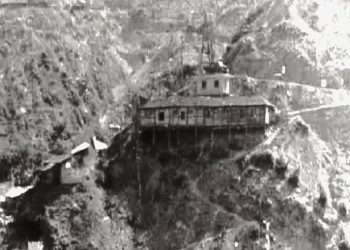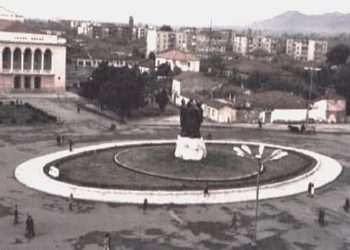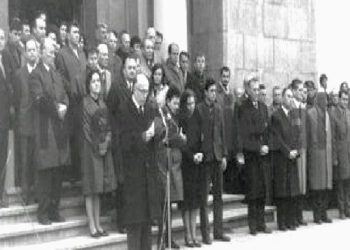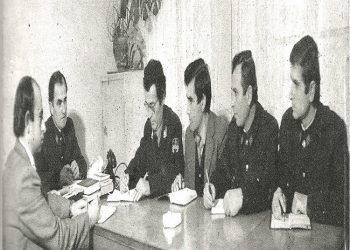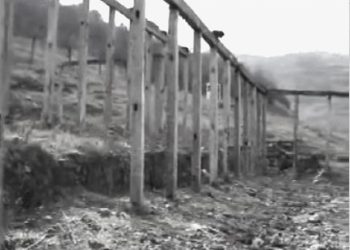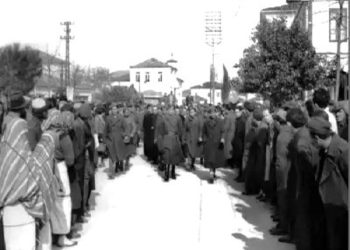By Prof. Dr. Muhamet Pirraku
Memorie.al / The political context of the demands of the Albanian demonstrations of 1968 cannot be understood outside the framework of the political spirit of the “New Left Movement” in France, Germany, England, with an initial impact on the “Demonstrations of Belgrade, at the beginning of June 1968. Distinguished from these with the clarified spirit, the all-Albanian populations of the nationwide political doctrine of Enver Hoxha, especially prominent from July 1966. Indeed, the Albanian generation of ’68, was created in the banks of secondary schools in the cities of Kosovo and in the faculties of Pristina and elsewhere in Yugoslavia, from the beginning of the 60s. The political and social motto of this generation can be summed up in a single sentence: “The sun rises and sets in Albania”! This concept of political thinking was brought to Kosovo by the activists of the “Albanian Irredentist Movement” of the early 50s: Qerim Ukë Ozdrimi, Hysen Thaçi, Skënder Kosova, Aziz Zhilivoda, Ajet Haxhiu, Bajram Rexha, Shaban Braha, Dervish Shaqa, Salih Shatri, and others, but strengthened the political messages conveyed to the fathers, first through Radio Tirana – Kukës and later through Albanian Television.
From the end of the 50s, precisely in 1957, the illegal Albanian political organization of Kosovo was founded, precisely with the formation of the “Revolutionary Movement for the Liberation and Union of Albanians” led by Professor Kadri Halimi. The political program of this organization was based on the political platform of the “Irredentist Movement” of the 50s, newly motivated with new demands. This indirectly comes from the meeting between Qerim Uka and Enver Hoxha, on January 2, 1963. Hoxha, who at the time was his own state, called the Kosovo issue a painful wound for every Albanian, “which will be healed only when this issue, to be resolved correctly, based on the aspirations of Kosovars”.
Based on this concept that dominated the political thinking of the new generation in Kosovo, in September 1963, the “Revolutionary Committee” was established under the leadership of Adem Demaç. This organization, during consolidation, will be renamed: “Revolutionary Movement for the (Liberation) Union of Albanians”, in fact, as a continuation of the one from 1957. In Article One of the Statute, approved in March 1964, among other things, it was specified: “The first and last goal of our movement is the liberation of the Albanian provinces, annexed by Yugoslavia and the union of these provinces with their mother – Albania”.
This demand, especially from the middle of August 1964, when the teacher Fazli Greiçevci was deprived of his life and after the end of the judicial process, for the “Adem Demaçi Movement”, will become a vital political demand of school youth, students and measures of Albanian things, in general. From the middle of 1966, precisely with the efforts for the all-Yugoslav official unmasking of the anti-Titus faction of the Serbian Ranković, marked the beginning of the semi-legalization of the Albanian demand, for equal rights with the other peoples of Yugoslavia, based on the right to self-determination , won with the Anti-Fascist National Liberation War.
The first step in this direction would be with the elevation of the autonomous status to the status of the republic of Kosovo, although the official Tirana still did not have the courage to openly support this request, precisely for fear that the Albanian anti-communist reaction, armed in Ballista memory, with the Yugoslav communist line, embodied in Titoism, against the Albanian revolutionary path of the Marxist-Leninist line embodied in populist Enverism. This is clearly seen from Enver Hoxha’s theses of July 23, 1966, in the article “Who is responsible for the crimes of genocide committed at the expense of the Albanian population of Kosovo and the Dukagjin Plain, Montenegro and Macedonia”, at the end of which marked the order:
“In addition to the data that we have, and that we will use, the Kosovar friends should also be asked about special events for those issues that I mentioned above, to be more precise.” Later developments showed that Enver Hoxha, in the future, based his political doctrine for the liberation and reunification of Ethnic Albania on the patriotism of the Kosovar patriotic intelligentsia. The “Kosovar” concept, for Enver Hoxha, included Albanians under Yugoslav captivity. In his directive: “The issue of the Yugoslav Federation should be closely related to the liberation of the peoples of Yugoslavia”, dated August 1, 1966, among other things, he specified: “Kosovo Albanians should not lie and abandon the revolutionary path. This is the only way of their liberation and self-determination.
To fight from now “for me to join Albania”, this does not lead you to the path. Kosovars are ardent patriots and union with Albania has been and is the ideal of their lives, but for them, there are only two paths, the revolutionary path and the reactionary – chauvinist path. The first is the path of war, land with the peoples of Yugoslavia. This path leads the Albanian people of Kosovo to the right of self-determination and to the union with the homeland, Albania.
The other way is adventure; on this path, even if fighting, the Albanians of Kosovo will become the prey of the Yugoslav reaction. The People’s Republic of Albania cannot help them by declaring war on the Yugoslav state. Only in the event that the Yugoslav state attacks or attacks the People’s Republic of Albania, then the situation changes, both for us and for the Kosovars, and this change takes place again in the Marxist-Leninist, revolutionary way, because the People’s Republic of Albania fights against the aggressor “.
Indeed, Albania’s position in the Balkan, European and world constellation was very bad, so the official Tirana, more precisely Enver Hoxha, will support with gloves, even the legal and institutional demands of the political and governmental bodies of the Autonomous Province of Kosovo and Metohija, for republic status within Yugoslavia. The lukewarm support of this request came as a result of the fact that official Tirana had no faith in the stability of those demands of the “Titist” political forces of Kosovo. This also comes from the directives of Enver Hoxha, on September 19, 1966: “The victory of the people of Kosovo, until self-determination, must come and be organized, in a long way, full of suffering, hardships and sacrifices by the people themselves and not from these sold heads, Albanians. The people of Kosovo can be led right on this path, and gain their full rights, only by true revolutionaries, Kosovar Albanians.
This is an absolutely necessary condition for success. The facts that are known are these: Kosovo and the other Albanian countries in Yugoslavia, part of Albania, were separated from their mother, by the imperialist powers and given to the Kingdom of Serbia. Kosovo is Albanian, remains Albanian and belongs to Albania” – specified Enver Hoxha, and after shedding light on the historical circumstances that influenced the fact why, after the victory over Nazi-fascism, “The people of Kosovo were not asked about their future”, as if he re-clarified the earlier instruction for the Kosovar patriots: “The people of Kosovo must clearly understand that the People’s Republic of Albania cannot attack or attack Yugoslavia. If Yugoslavia attacks Albania, that is another problem. Albania will defend itself, it will fight and we will win. Then the problem of Kosovo will be completely different”.
In the spirit of his political, all-Albanian, populist doctrine, Enver Hoxha addressed the Albanian and Serbian participants from Kosovo, at the “Symposium for Skënderbeu”, on January 15, 1968, in Krujë: “We salute you, as the representatives of the Kosovar intelligentsia and as sons of that heroic part of the Albanian people of Kosovo, which we love very much. You are Albanians and we are Albanians, so we are one people. The heavens may fall, but the truth, that you are our brothers, and that we are your brothers, why we have a motherland, a homeland, does not move. Terrible storms have passed over the Albanian people.
They may do such things tomorrow, but the Albanian people will not be enslaved by anyone anymore. There is no force in the world that can stop the Albanian people from living united, free, independent and sovereign. Ancient and modern times have proven this. If the circumstances beg, this will be proven in the future. We cannot refrain from telling these great truths; otherwise we would be committing a crime. What I am telling you now, I also told Tito, when I met him for the first time, in 1946 in Belgrade. He listened to me and, when I finished, he asked me what I thought about Kosovo. I told him: – Kosovo is Albanian, belongs to Albania and must be returned to Albania”.
At the end of the note, Enver Hoxha concluded: “From the impression I had, it seems to me that they listened with great attention, their faces were very expressive. Apparently, they parted satisfied. One thing is certain and it will be similar, what I said, they will spread in Kosovo. This will be positive”. Indeed, it happened. The words of Enver Hoxha, went ear to ear, in every Albanian hearth. He also sent special orders, political guidelines for the patriotic intelligence, to the participants from Tirana, at the Symposium on Skënderbeu, at the beginning of May 1968, in Pristina.
The arrival of the scholars from Tirana, missionaries of Enver Hoxha, to their surprise, in Pristina found the table of national, unique all-Albanian political activity. There was a galaxy of creative intellectuals here, representing different fields: in education, in administration, in culture, in Albanian and historiographical sciences, in media and journalism, really connected in a group of friends, of an intimate political opinion, self-named: “Ceta e Bajo e Çerçiz Topulli”.
The name of this group today sounds romantic, but for the time, it was an ideological determinant of Albanian nationalism. The activists of this group were the perceivers and transmitters of messages that radiated from the glorious history and official Tirana. The “Bajo e Çerçiz Topulli” group, apart from the fact that there was at least one sworn follower of the “Revolutionary Movement for the Union of Albanians” of Adem Demaçi, until now, had an activity of more than four years, as a link of what it could be called illegal (radiation from Tirana) with Albanian patriotic dissidence, in the communist – Titoist circles of Kosovo. Within this circle of intellectuals, the idea for the 1968 demonstrations was forged (see IDEA/1 an), designed as “student”, while the blue eminence in this line-up was the educator Ismail Dumoshi.
Here, for the sake of scientific reality, we must highlight the fact that: the Albanian populist spirit of Enver Hoxha was also a dominant dissident spirit, even in the discussions in the communal and provincial communist activities as well as in the four-party working collectives of Kosovo, from August to October , of 1968 – for the constitutional changes in Kosovo, for the Constitution of Kosovo and for the status of the republic of Kosovo, an equal state unit, with the other republics in the Federation of Yugoslavia. This was considered as the most promising step for the realization of the self-determination of the Albanians, in a calmer, or more turbulent, future.
Let’s also bring this fact: Many of these that were summarized above, can also be observed against the accusations that Enver Hoxha, on December 5, 1968, returned to the Titoists of Kosovo and Yugoslavia, regarding their evaluation, that: “The demonstration of 27 November in Pristina, it was instigated ‘from outside’, referring to the official Tirana. Without hiding the influence of the official Tirana, in the developments throughout the Albanian area, under the state administration of Avnoist Yugoslavia, Enver Hoxha will state, among others: “The demonstrations that took place are the prelude to the patriotic symphony of the Kosovo Albanians.
Titists shout in vain that we are interfering. No, this fire has its hearth inside Kosovo itself. The fire is lit by the patriotism of Kosovars and their legitimate demands; the fire is fueled by Titist oppression and slavery. The bright beacon of the Labor Party of Albania cannot help but become an example and guide, not only for the Albanians of Kosovo, Macedonia and Montenegro, but for all the peoples of Yugoslavia, who are fighting for liberation. Dashka not dashka Tito, the Albanians of Kosovo, have their eyes and heart in the People’s Republic of Albania, in the PPSh”.
What Enver Hoxha was saying now was a reality that every Yugoslav knew. But, we must state the fact that; the explosion of the demonstration on November 27 in Pristina, the official Tirana, came quite unexpectedly. Academician Kristaq Prifti, who at that time worked in the Kosovo section of the PPSh Central Committee, on the day that for the first time, Pope John Paul II was stepping on the soil of Tirana (spring 1993), confirmed to me the fact: “It took three or four days for Enver Hoxha to establish the official state position of Albania for the November demonstration in Pristina…”!
In the communist circles and the Yugoslav UDB, there will also be thoughts that; the demonstration of November 27, 1968, was organized by NKVD spies, (Soviet), as revenge against Yugoslavia, for its stance against the Russian incursion in Czechoslovakia, which happened after the student demonstrations in Belgrade. From Tito’s Udba circles, and Tito’s nostalgics, later, the accusation that; the demonstrations of 1968, as well as those of 1981, were “organized” by the Serbs, to create an alibi, against the autonomous status of Kosovo.
These ominous accusations, surprisingly, were whispered by former Titoist Albanian Udbas even now, as soon as the news was published about the holding of a scientific activity for the “Demonstrations of ’68”. Since I also have facts, from personal knowledge of the course of the event, this forced me to decide to participate in this scientific activity, precisely with this statement, to illuminate the main aspects of the political context, the demands of the 1968 demonstrations, with a focus on formulating the programmatic demands of the “November 27, 1968 Demonstration” in Pristina. For that, we have to go a little further. Let’s reiterate the fact that; the idea of organizing student demonstrations in Pristina began to take hold, as soon as the “New Left Movement” was shaken, in France, in Germany, in England, but with the explosion of student demonstrations in Belgrade, at the beginning of June 1968, it seemed as if the clock was ticking for the rise of the students of the faculties of the University of Belgrade, in Pristina.
The author of this letter (the archive for the research and publication of archival material at the State Archives of Kosovo), at that time for scientific research work in Belgrade, not only supported the demands of the “Participatory Political Program”, the demonstrations in Belgrade, but also contributed with dedication poems, in the Serbian language, which will be recited by different students. In fact, their author, Çerçizi of the “Ceta e Bajo e Çerçiz Topulli”, continuously, with phone calls and hand-to-hand information, informed the collaborators, who gravitated to the above-mentioned “Ceta…”, namely Tahir Abdylin and Ismail Dumoshin, and others, for the course of the demonstrations, as experience for the organization of student demonstrations in Pristina, as soon as they ended in Belgrade.
The turn that happened in the character of the demonstrations of the University of Belgrade, after the infiltration of Serbian nationalist professors from the neighborhood of Dobrica Qosiqi, before it became public, the author of this statement, from the place of the developments, informed the collaborators of “Ceta e Bajo e Çerçiz Topulli” and preferred to wait for developments, on the other hand, he addressed a memorandum to Tito on several pages of writing, with demands for equality and political and national freedom of Albanians, with the right to self-determination, based on of the victory of the National Liberation Anti-Fascist War, sublimated in the Resolution of the Bujan Conference. The document was signed with the phrase: “Albanian Youth Committee”.
The dispersal of demonstrations in Belgrade with brutal police violence, the Russian threat to Yugoslavia, which is also dangerous for Albania, Enver Hoxha’s speech in defense of Yugoslavia and the institutional start of discussions on constitutional changes in Kosovo, with very advanced national public demands, led to , the intellectuals united in the “Bajo and Çerçiz Topulli Squad”, although they strongly doubted the institutional victory, decided to join the efforts, within the efforts, of the Albanian institutional political instances of Kosovo. This, as seen above, was also a clear order from the head of Albania’s government pyramid. The request for raising the autonomous status, to the republic status of Kosovo, was finally elaborated, in the two-day meeting of the political activity of the Municipality of Pristina, at the beginning of September 1968, in which the police, government and university and scientific elite participated. , of Kosovo.
The author of this statement came from the State Archives of Kosovo and kept complete notes on the developments. The failure of public discussions about the “Republic” status of Kosovo, which would also drag behind other solutions of an economic, cultural, political and national character, for all Albanians under Yugoslav captivity, strongly influenced the reawakening and consolidation of the anti- -Yugoslav, of the intelligentsia and of the Albanian masses. In a chain way, demonstrations will break out in Prizren on October 6; in Theranda, on October 8; in Peja, on October 19; in Pristina, Besia, Gjilan, Ferizaj and Mitrovica, on November 27; in Tetovo, on December 22 and 23, 1968 and in Ulcinj, in June 1969. An empirical research would reveal the facts, where and to what extent; the activists of the “Ceta e Bajo e Çerçiz Topulli” were present.
The demands of the demonstrations went in support of the economic, political and national demands, declared in the meetings of the political assets in Kosovo, finally the meetings of the political assets in Pristina. In the chain of Albanian demonstrations of 1968, the one on November 27 in Pristina, dedicated to the Independence Day of Albania, the Day of the Albanian National Flag, particularly shocked the Yugoslav opinion and aroused the interest of political circles, of establishment in Europe and in world, for two main reasons:
The first, was well organized, it was comprehensive – student, school, intellectual and all popular, and the second, due to the fact that; it made programmatic political demands, for the right to self-determination of the Albanians in Yugoslavia, on the basis of the Marxist-Leninist-Enverist political philosophy, which was considered as the only promising possibility for the solution of the Albanian issue, violated by unjust decisions of Europe, in 1878, in 1913, in 1920 and with the Anglo-American-Russian decisions of the Second World War.
I feel it is a scientific duty to briefly reflect the historical truth regarding the political demands of the speech read by the student of the Technical Faculty, Osman Dumoshi. They are widely elaborated requests, by special activists of “Ceta e Bajo e Çerçiz Topulli”, with the direct commitment of Ismail Dumoshi. From the middle of November 1968, the exhibition “60-Anniversary of the Congress of Manastir” was opened in Pristina. It was this cultural event, never experienced in the Albanian lands, under Yugoslav captivity. Its Cicero, who was also one of the bearers of the research of the facts and its breeding, as well as many activists of “Ceta…”, professors, journalists and publicists, will use the exhibition, for national propaganda, among the student youth school, and will test the possibility of the size of the participation of the youth and the people, in an eventual demonstration.
Ismail Dumoshi, teacher and director at the School Center in Kastriot, continued to be the blue eminence of what will happen on November 27 in Pristina. Together with “Cherçiz”, in the “Khajami” cafe, having in front of him the “Participatory Political Program” of June 4, 1968, of the “Red University – Karl Marx” of Belgrade, as well as the notes from the Political Activity Meeting of Pristina, they discussed and formulated the main demands, which would find a place in the speech for the demonstration. In reality, the path of reduction, of softening the demands of Belgrade demonstrations and gatherings of communist political assets, was followed in Kosovo. It was the general attitude of the members of the “Ceta e Bajo e Çerçiz Topulli”, that care should be taken for the epilogue of the demonstrations, precisely the possibility of the defense before the trial, of the potential prisoners.
There was no unique position, that the Albanians’ right to self-determination was included in the demands, as a special point, but it was implied by the content of the speech that was to be drafted. With the persistent request of the author of this statement, Ismail Dumoshi, it will be agreed that in the demands that would be emphasized in the programmatic speech, it should not appear for the status of “Republic of Kosovo”, due to the fact that it was too bent, in the Titoist Albanian party discussions , conflicted with the demands of LANÇ (National Liberation Antifascist War) with the political program of ONDSH, and with the statute of the “Revolutionary Movement for the Union of Albanians”, as well as with the directives of Enver Hoxha, for intellectuals, national Kosovars.
The status of “Republic of Kosovo” did not solve the Albanian issue definitively. (= with S. Novosellan) From now on, with the so-called “Committee of the Demonstrations of November 27, 1968” (not the “Political Group”, as heard at the Scientific Conference of November 24 and 25, 2008), will work directly, only Ismail Dumoshi, but invisibly or openly, helped by Hasan Salaj, Demë Fetaj, Murat Blaku (Bajo) and others.
The students who organized the November 27th demonstration, as well as the students and intellectuals who organized the demonstrations in other cities, before and after November 27th, were not manipulated by anyone; they were predetermined by themselves, as potential killers of national freedom. . Meanwhile, the activists of “Ceta…” – high school professors: Fehmi Pushkolli (in the Normal School), Demë Feta (in the Technical School), Ismail Dumoshi (in the School Center) will contribute to the great size of the participation in the demonstrations. in Kastriot), Idriz Gërvalla (at the School of Economics and of the Entit for Framing), then Hasan Salaj e, Xhakush Çapari, at Radio-Prishtina, Gani Bobi at the newspaper “Rilindja”, Halil Alidemaj, at the Municipality of Pristina.
The students of Philosophy, Economics and Law were mainly dealt with: Tahir Abdyli, Murat Blaku, Pirraku, and others, with the Technical students, mainly the technician students, gathered around Osman Dumoshi, while the blue eminence, Ismail Dumoshi , will also deal with the workers of the Electro-Economy of Kosovo. The movement also brought other people to the fore: intellectuals, students and pupils, worthy of leaders and ready for personal victimization, for the interests of the nation.
Let’s also add this: the activists of the “Cheta e Bajo e Çerçiz Topulli” carried the main burden even during the judicial process, of the leaders of the demonstration of November 27, 1968, in Pristina. With a competently studied consent, a lawyer from Belgrade, Fila Filota, will be engaged, but also for the collection of voluntary contributions, for the defense. Lawyer Filota, during the trial process in the District Court in Prishtina, was located in the “Metohija” hotel in Peja. The defense was dignified, even against the will of some of the arrested, which did not prefer acquittal.
The activists of the “Ceta e Bajo e Çerçiz Topulli” provided written data, for the needs of the defense, to lawyer Filota. The author of this statement carefully conveyed the judgments of the organizers of the “Albanian Demonstrations of ’68”, kept special notes on the court proceedings and punishments, while the others, from “Ceta e Bajo e Çerçiz Topulli”, according to affinity and opportunities, personally or through trusted ones, as well as before the demonstrations, they informed the diplomatic representatives of Albania, and others, in Belgrade, Sofia, Bucharest, Budapest, Vienna, Istanbul, Ankara, Thessaloniki and elsewhere, about the situation in Kosovo and in Albanian lands under Yugoslavia.
Now, I believe, we have a clearer political context of the demands of the Albanian demonstrations of 1968 in Kosovo, but we also have a clearer reason why the written demands of the organizers of the November 27, 1968 Demonstrations did not the request for the republic status of Kosovo was also introduced, but which will be cheered by the demonstrators as inertia remaining from public discussions in the political activities of the League of Communists of Kosovo. The author of this statement is still loyal to the Political Demand for Self-Determination of the people of Kosovo, while the “supervised independence” status of Kosovo is evaluated by international violence, the same as the “Principality of Albania” status of 1913. Memorie.al




